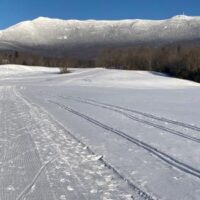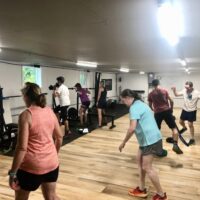It was a week for a little more speed among the Junior squad, including one of the most quintessential workout on any modern skier’s checklist: double poling up a hill a bunch of times in a row!
We once again stormed the streets of Williston for the first round of DP repeats this season. We tried to expand out thinking beyond just cues for one type of double poling, as there are actually many ways to best utilize the combinations of body position, upper body, lower body, timing, and follow-through to best get through a given section of terrain.
As this technique has evolved, we’ve had to think harder about how to teach and review double poling. Rather than just doing drills on flat ground, we began with drills on a gradual downhill in order to feel what long glide, full follow-through, and really forward-reaching movements felt like.
Next, we went to the steepest hill we could access in the neighborhood, and did several drills and repeats on this hill in order to see the “opposite end of the spectrum” when it comes to tempo, follow through, and usage of the lower body.
Only after this did we then move onto the repeats themselves, up a gradual hill with a bit of undulation. The goal was that by experiencing the extremes of terrain, the skiers would have a range to work with as they honed-in on the most efficient way to tackle this hill.

Wheels were traded for shoes, but the intensity got even higher on Saturday with the first fitness test of the summer: the 3000m run. New this year was a 400m test, but more on that later…
The 3000m test is great because of its simplicity. It also is a test that so many teams do, meaning data points are easy to track and learn from. For many, this was the first “race” since late season ski events like Easterns, JNs, U16s, and Supertour Finals. To that end, one stated goal was to work on not just literal targets like times and splits, but the mental side of things.
During many spring athlete meetings, a common theme was working on race psychology both before and during competition. What better time to engage with this than the first effort of the year? Things got off to a great start with the team all arriving and getting started with warmups on their own, even jumping into our now-routine mini band work for hip activation and stability. Having familiar structured elements to a warmup really helps get the body and mind into the right state to perform.
And then the performance itself was underway! We had a great test, with lots of personal bests for this springtime running of the event.

Men’s group rounding the first lap
After the conclusion of the 3o00m test, everyone did a 400m test (1 lap of the track) which was a new addition from MNC University coach (and UVM coach) Brandon Herhusky.
The goal? Use a formula after-the-fact to get a percentage of 400m lap (fast-twitch) pace relative to 3000m lap pace (slow-twitch). That ratio helps show whether or not a skier can be working on one end or the other…some may have not been too surprised to find they were more slow-twitch! We’ll work on ways to introduce and adapt individual needs accordingly, and it’s always cool to see more data!




Comments are closed.